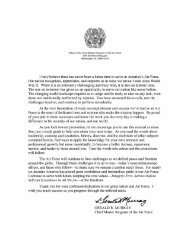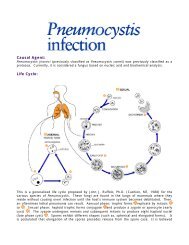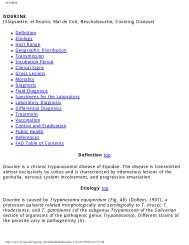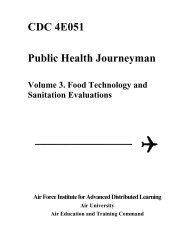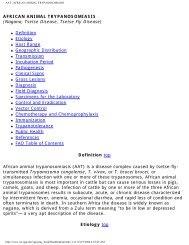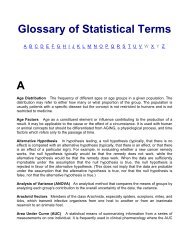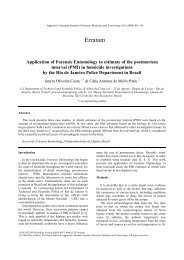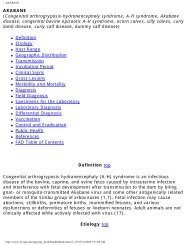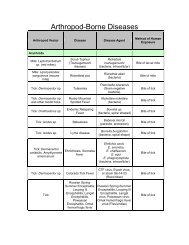HEMORRHAGIC SEPTICEMIA
HEMORRHAGIC SEPTICEMIA
HEMORRHAGIC SEPTICEMIA
You also want an ePaper? Increase the reach of your titles
YUMPU automatically turns print PDFs into web optimized ePapers that Google loves.
<strong>HEMORRHAGIC</strong> <strong>SEPTICEMIA</strong><br />
indirect hemagglutination test of Carter (5), and the numeral 2 stands for the<br />
somatic or O antigen as determined by the agar gel diffusion precipitin test<br />
developed by Heddelston and associates (17). This somatic antigen 2 is the<br />
equivalent to the 6 in the classification of Namioka and associates. In a new<br />
classification, Pasteurella multocida strains causing most pasteurella infections,<br />
including hemorrhagic septicemia, are called P. multocida subspecies multocida.<br />
Host Range top<br />
Cattle and water buffaloes are the principal hosts of hemorrhagic septicemia, and<br />
it is widely considered that buffaloes are the more susceptible. The disease is<br />
thought to be endemic in one large herd of North American range bison; however,<br />
epidemics appear to be rare. In the United States, the disease has been confirmed<br />
only in American bison in 1912, 1922, and 1965. The P. multocida isolant from the<br />
1922 outbreak, a serotype B:2, is maintained in the USDA culture collection as a<br />
reference strain. Although outbreaks of hemorrhagic septicemia have been<br />
reported in sheep and swine, it is not a frequent or significant disease. Cases have<br />
been reported in deer, elephants and yaks. There is as yet no evidence of a<br />
reservoir of infection outside the principal hosts: cattle, water buffaloes, and<br />
bison.<br />
Geographic Distribution top<br />
Hemorrhagic septicemia in epidemic form is a disease mainly of cattle and water<br />
buffaloes either maintained separately or together. Radical changes in weather,<br />
including the advent of monsoons, debility caused by seasonal levels of low<br />
nutrition, and the pressure of work (draft animals) are related to the explosive<br />
occurrences of the disease in certain parts of the world. Southeast Asia, where<br />
such conditions often coincide, is the area of highest incidence. The disease occurs<br />
in the Middle East and Africa where the environmental circumstances and<br />
predisposing conditions are not as clearly defined as in Southeast Asia. As in Asia,<br />
the disease is frequently associated with the rainy season and poor physical<br />
condition.<br />
Hemorrhagic septicemia was recognized in Japan as a specific disease of cattle<br />
caused by particular strains of Pasteurelia as early as 1923. Since 1926, the<br />
disease has been controlled, and the last recorded case in cattle in Japan occurred<br />
in 1952.<br />
The B:2 serotype has been recovered from hemorrhagic septicemia in countries of<br />
Southern Europe, the Middle East, and Southeast Asia, including China. This same<br />
serotype has been reported from Egypt and the Sudan. The E:2 serotype has been<br />
http://www.vet.uga.edu/vpp/gray_book/Handheld/hes.htm (2 of 8)3/5/2004 4:15:01 AM



